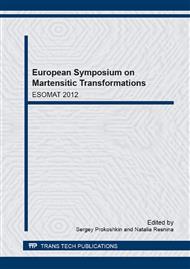p.269
p.274
p.276
p.281
p.287
p.292
p.297
p.301
p.306
Evolution of Temperature Profiles during Stress-Induced Transformation in NiTi Thin Films
Abstract:
This paper presents a time-resolved investigation of tensile loading induced temperature profiles in pseudoelastic NiTi thin film specimens. A finite element model for coupled mechanical and time dependent thermal analysis is presented that accounts for the different effects of local generation of latent heat and heat transfer. For strain rates larger than 0.24/s, the maximum temperature increases from room temperature to above 50 °C. Subsequent stress relaxation after temperature compensation results in a temperature decrease from room temperature down to -20 °C. The observed evolution of temperature profiles is in qualitative agreement with infrared thermography experiments on NiTi films fabricated by magnetron sputtering.
Info:
Periodical:
Pages:
287-291
Citation:
Online since:
January 2013
Price:
Сopyright:
© 2013 Trans Tech Publications Ltd. All Rights Reserved
Share:
Citation:


